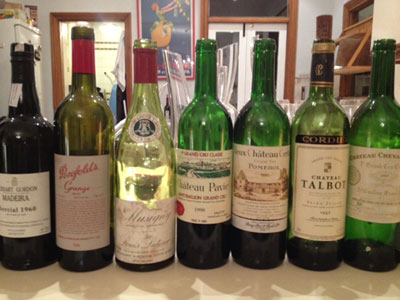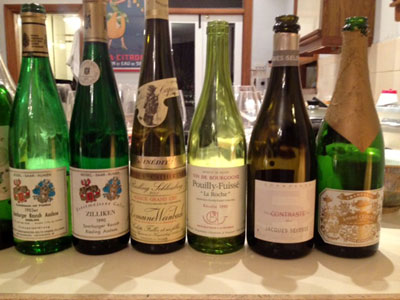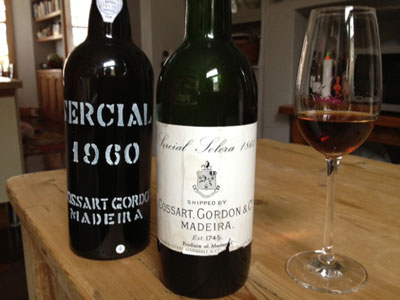For many years I have been part of a tasting group whose members have changed over time but the basis of which has always been that we have gathered and each person has brought along a bottle, or two, which is then served blind to the rest of the group. The idea is of course to delight but if possible also to confuse. I can honestly say that UFBs have been responsible for allowing me to taste and share some of the greatest wines ever but they have also embarrassed me no end by my inability to taste blind and left me with some world class hangovers.

The Reds
|
I should at this point explain that the name came about from one of the original members of our group, James Suckling, whose highest expression of approval is not in fact 100 points but “un-[expletive deleted] believable”; hence UFB. Incidentally the mother of all hangovers came from an evening when James was researching his book Vintage Port. He hosted the evening and cooked some very fine food and we all brought our bottle or bottles and James filled in the gaps. In fact he created gaps in order to serve a few more wines than was sensible. We reached the end of the meal and James then served three bottles of vintage port. As someone who is now suspicious of ending a meal with just one bottle of port, I can assure you that three bottles is not just overkill but close to total annihilation.
Last week I hosted an evening with some ex colleagues from Farr Vintners as well as Simon who has been ever present it seems. Simon was responsible for one of the great UFB tricks which illustrates my point about the confusion that a UFB should ideally create. He served us a wine at the beginning of the meal. We all guessed it correctly as Bordeaux, not a great feat as Simon rarely serves anything else, believing that the first responsibility of a wine is to be red and the second is to be Bordeaux. However when Simon's next red was served after various other wines had been and gone we again guessed Bordeaux and argued about what it might be. No-one recognised that it was the same wine that we had drunk at the beginning of the meal served from a magnum. Simon had decanted and served the first half of the mag at the beginning of the meal and the second half at the end of the meal. The embarrassment was a perfect example of the desired effect of showing up our inability to taste. Our excuse was of course that the extra 2 hours that the second wine had to breathe had made it unrecognisable. Simon however knew that he had fooled us.
So to last week's dinner; I always try if possible to have a theme that links wines and while I could not theme the wines that the others brought I could try and set up something where I could invite the others to guess the relationship between a pair of wines. I like serving wines in pairs so that one can taste side by side, which works as long as there is a link between the wines.
My first pair was two sparkling wines. Easy to guess that both were champagnes and eventually that they were two blanc de noirs. Selosse Contraste looked and tasted about 20 years older than the other wine. I knew that this was a wine that gets better with air and I had decanted it but not long enough in advance as it was only the next evening that the freshness emerged from the glass. It is a great trick as the wine initially seems over the hill but with air spring flowers and freshness leap out from the glass. On the evening itself the next wine was generally preferred as it was more youthful and fine. This was Andre Clouet Cuvee 1911. This is produced in a tiny quantity of 1911 bottles. The version that we drank was the cuvee comprising 25 % each of 1995 and 1997 and 50% 1996. Beautifully fresh with the vivacity that the 1996 acidity gives but filled out with a more rounded feel from the other two vintages this is a wine that combines fruit that is no longer primary with a gorgeously pointed attack.
My next pair was clearly a pair of Rieslings. This was probably not hard to guess as my friends know that Riesling will appear at my table as it is one of my great favourites. On this occasion I had two different vintages of the, just about, same wine. Both were Saarburger Rausch Auslese Goldkap. The 1990 was however an auction wine while the 1983 was the regular release. The difference is that every year the growers sell their best cuvées from their very best barrels via the Grosse Ring auction in Germany and these wines are seen as being the greatest and invariably most expensive expressions that the vineyard is capable of.
The Grosse Ring is the most bizarre auction that I have ever been to. One usually associates auctions with frenzied bidding and raised hands as individuals battle to buy what they want. Not at the Grosse Ring. Here the strangeness begins in that each wine to be sold is first of all served to everyone in the hall which can be 200-300 people. You will end up tasting 60 plus wines and the auctions last 6 or more hours.
The next difference is that you do not bid yourself but you sit on a team table represented by one of six commissioners who act for you. The idea is that before the auction you tell your commissioner what you want to buy and how high you are willing to go to get it. The auctioneer who has maybe 360 bottles in one lot to sell starts off at 10 euros and goes up and up with no action happening in the room until at some point all the commissioners get up and move to the centre of the room to talk. Apparently they discuss what their customers want and the price they want to pay and come to an agreement about how to split the lot. If they are paying a very good price they can ask the producer if he might like to release more than the initial 360 bottles to keep everyone happy. If however one commissioner has a client who is not willing to compromise on the quantity that they will receive he will push the price to a level where he gets what he wants but this can mean that the other bidders may have fallen out and so not all of the lot may be sold with the balance going back to the producer. Not a problem you might think except that part of the system ensures that the growers undertake never to sell the wine at a cheaper price than the hammer price in the auction.
One other feature that seems designed to confuse is that the auction wines (Versteigerungs Weine in German) are identified by a round sticker that appears on the neck of the bottle that says “Grosse Ring” and the year of the auction. It is however sometimes possible to buy the same wines directly from the grower later but these late release bottles do not have the Grosse Ring stickers on them. They can be identified as being the same wine by the unique AP number which appears on the bottom of the label in very small printing which identifies each separate cuvée. These can then have an accompanying letter from the estate saying that this is in fact the same wine as that which was sold at the auction but they do not have the little sticker on them. It is just another example of how difficult it is to get a grip on German wines. They really do not help themselves to sell their wines abroad.

The Whites
|
Back to the 1990 and 1983 Saarburgers. The 1983 which is a great vintage and has produced very classic late harvest wines was a bit muted and lacked the sparkling clarity that the 1990 had. The 90 was rich but had brilliant acidity so that the end effect was of not of a sweet wine but of something very full bodied and in perfect balance. Richness without acidity can leave the palate tired quite quickly but this wine shone with a brilliant gem like quality. The finish had great length and shimmered with a clean bright quality that was like a powerful searchlight cutting through the rich gloom; brilliant wine that went very well with the soft shell crab with chilli that it was served with. Asian food thrives on balance and the sweetness of this wine went very well with the spicy heat of the crab accompaniment.
My final act of the evening was a pair of wines that were quickly identified as Madeira. This may be a reflection on the astute palates of the Farr team or it may be that a great part of blind tasting involves knowing the tastes and cellar of the person serving the wine. It is generally known that I am a great Madeira fan so maybe this was not the great tasting feat it might appear. However the table quickly established that we had a pair of Sercial wines in front of us. I then gave a clue to help further guessing by saying that once again I was serving the same wine but in different vintages. The trick this time however, and it was one that no-one got, was that these were vintages that were 100 years apart. It is the only time in my life that I have ever managed to get such a big gap between a pair of wines. The first wine was a 1960 Sercial Cossart Gordon. It had the classic precise attack that sercial, the driest of the four classic Madeira styles has. It was however also rich with citrus fruits and a touch of molasses and Christmas cake fruit. It was fatter and more dense than the next wine.
The 1860 Sercial Cossart Gordon is like drinking a laser beam. It has a piercing quality to it that is even more rapier like than its younger relative. By this age there is not much fat on the palate but it grips and goes on and on with a finish that evokes something both fruity and savoury. There is a saline quality to the wine which gives it a refreshing feel. Port makes me feel tired with it’s sweet fruit whereas madeira always has an underlying acidity that wakes both me and my palate up and provides the perfect way to end an evening. It is a brilliant sipping wine as each taste reverberates around the mouth, it makes me salivate and it leaves me, for one, feeling replete but not over tired.

Two Madeiras
|
I love wine and am fascinated by how it changes over time. I have been lucky enough to drink some great old wines but there are few wines that can match Madeira's ageing ability. How many other wines could be served as a pair 100 years apart? I have drunk 19th century Bordeaux but on the whole it's like meeting a very old lady. You give them marks just for being alive but Madeira is not just alive at the age of 150, it positively sparkles with life. It also has the benefit that once opened it will not deteriorate in the bottle as other wines do. It is already oxidised so further exposure to oxygen does not harm it. It is the perfect thing to open and drink over an extended period.
I was pleased with the whole evening and we drank some great wines but I doubt I will ever again be able to serve wines and say they are the same wines just separated by 100 years.